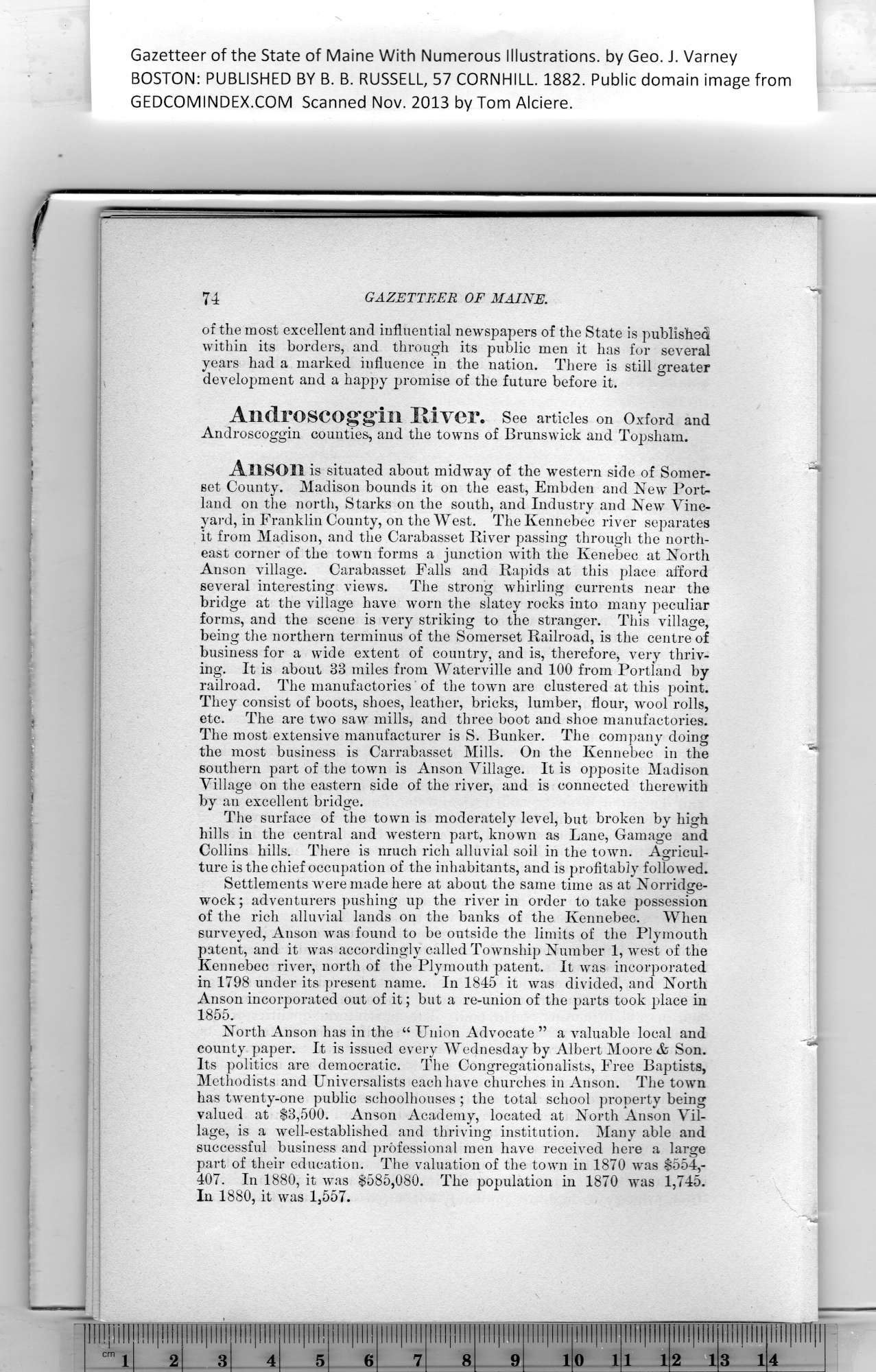|
Gazetteer of the State of Maine With Numerous Illustrations, by Geo. J. Varney
BOSTON: PUBLISHED BY B. B. RUSSELL, 57 CORNHILL. 1882. Public domain image from
74 GAZETTEER OF MAINE,
of the most excellent and influential newspapers of the State is published
within its borders, and through its public men it has for several
years had a marked influence in the nation. There is still greater
development and a happy promise of the future before it.
Androscoggin River. See articles on Oxford and
Androscoggin counties, and the towns of Brunswick and Topsham.
Anson is situated about midway of the western side of Somer-
set County. Madison bounds it on the east, Embden and New Port-
land on the north, Starks on the south, and Industry and New Vine-
yard, in Franklin County, on the West. The Kennebec river sejjarates
it from Madison, and the Carabasset River passing through the north-
east corner of the town forms a junction with the Kenebec at North
Anson village. Carabasset Falls and Rapids at this place afford
several interesting views. The strong whirling currents near the
bridge at the village have worn the slatey rocks into many peculiar
forms, and the scene is very striking to the stranger. This village,
being the northern terminus of the Somerset Railroad, is the centre of
business for a wide extent of country, and is, therefore, very thriv-
ing. It is about 33 miles from Waterville and 100 from Portland by
railroad. The manufactories' of the town are clustered at this point.
They consist of boots, shoes, leather, bricks, lumber, flour, wool rolls,
etc. The are two saw mills, and three boot and shoe manufactories.
The most extensive manufacturer is S. Bunker. The company doing
the most business is Carrabasset Mills. On the Kennebec in the
southern part of the town is Anson Village. It is opposite Madison
Village on the eastern side of the river, and is connected therewith
by an excellent bridge.
The surface of the town is moderately level, but broken by high
hills in the central and western part, known as Lane, Gamage and
Collins hills. There is much rich alluvial soil in the town. Agricul-
ture is the chief occupation of the inhabitants, and is profitably followed.
Settlements were made here at about the same time as at Norridge-
wock; adventurers pushing up the river in order to take possession
of the rich alluvial lands on the banks of the Kennebec. When
surveyed, Anson was found to be outside the limits of the Plymouth
patent, and it was accordingly called Township Number 1, west of the
Kennebec river, north of the Plymouth patent. It was incorporated
in 1798 under its present name. In 1845 it was divided, and North
Anson incorporated out of it; but a re-union of the parts took place in
1855.
North Anson has in the “ Union Advocate ” a valuable local and
county paper. It is issued every Wednesday by Albert Moore & Son.
Its politics are democratic. The Congregationalists, Free Baptists,
Methodists and Universalists each have churches in Anson. The town
has twenty-one public schoolhouses ; the total school property being
valued at $3,500. Anson Academy, located at North Anson Vil-
lage, is a well-established and thriving institution. Many able and
successful business and professional men have received here a large
part of their education. The valuation of the town in 1870 was $554,-
407. In 1880, it was $585,080. The population in 1870 was 1,745.
In 1880, it was 1,557.
PREVIOUS PAGE ... NEXT PAGE
This page was written in HTML using a program written in Python 3.2
|
